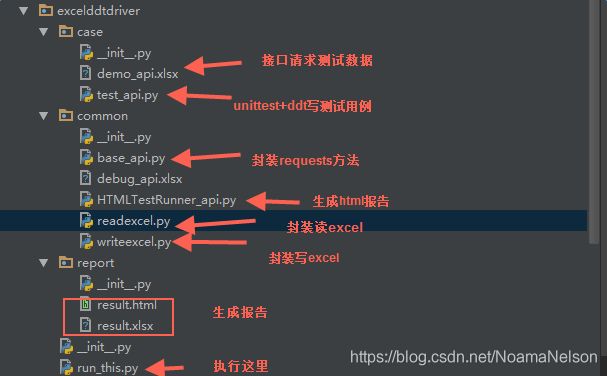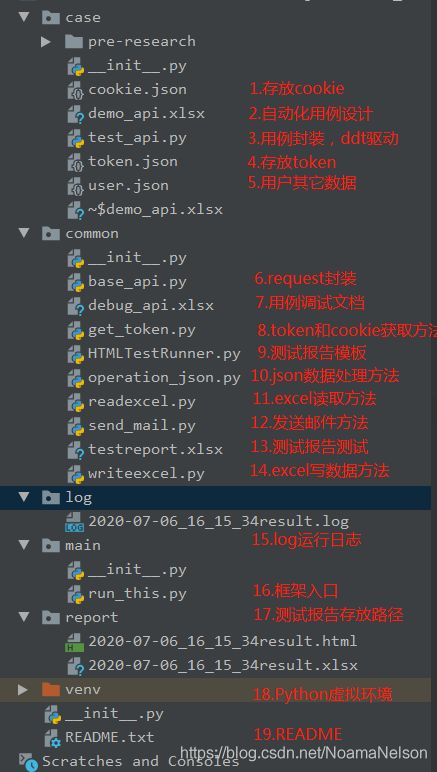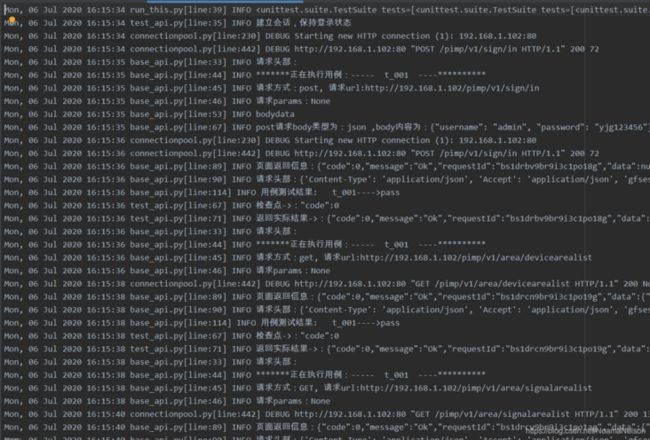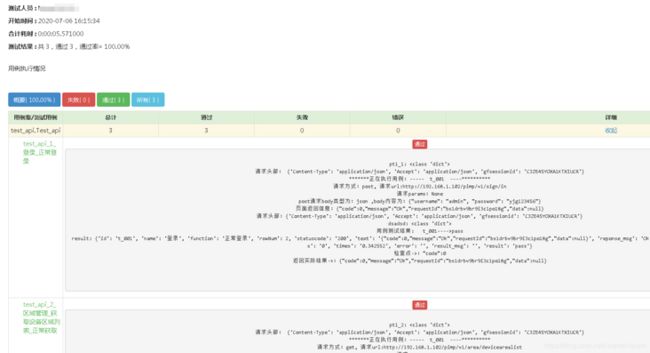本文章内容是基于上海-悠悠的版本,进行了优化,增加了部分内容,详细请查阅下文。
@TOC
1、原文链接
python+requests+excel+unittest+ddt接口自动化数据驱动并生成html报告
2、修改前后框架区别
3、主要修改内容
- 增加:token关联(token获取和保存)
- 增加:cookie关联(cookie获取和保存)
- 增加:发送邮件(使用SMTP)
- 修改:HTML报告模板中的样式和ddt用例的标题
- 增加:logo日志
### 4、详细修改内容说明
#### 4.1、增加token关联
##### 4.1.1、token获取get_token.py
import json
import requests
from common.operation_json import OperetionJson
class OperationHeader:
def __init__(self, response):
# self.response = json.loads(response)
self.response = response
def get_response_token(self):
'''
获取登录返回的token
'''
token = {"data":{"token":self.response['data']['token']}}
#token = {"token": self.response['data']['token']}
return token
def write_token(self):
op_json = OperetionJson()
op_json.write_data(self.get_response_token())
def get_response_msg(self):
reponse_msg = {"msg":self.response['msg']}
#print("reponse_msg:", reponse_msg)
return reponse_msg4.1.2、token保存operation_json.py
#coding:utf-8
import json
class OperetionJson:
def __init__(self,file_path=None):
if file_path == None:
self.file_path = '../case/cookie.json'
else:
self.file_path = file_path
self.data = self.read_data()
#读取json文件
def read_data(self):
with open(self.file_path, 'r', encoding='utf-8') as fp:
data1 = fp.read()
if len(data1) > 0:
data = json.loads(data1)
else:
data = {}
return data
#根据关键字获取数据
def get_data(self,id):
print(type(self.data))
return self.data[id]
#写json
def write_data(self,data):
with open('../case/token.json','w') as fp:
fp.truncate() # 先清空之前的数据,再写入,这样每次登录的token都是不一样的
fp.write(json.dumps(data))4.1.3、token的读取base_api.py
在原代码中加入token的读取,即把token加入到heasers中
# 请求头部headers
try:
headers = eval(testdata["headers"])
if testdata["token"] == "yes":
op_json = OperetionJson("../case/token.json")
token = op_json.get_data('data')
headers = dict(headers, **token)
print("请求头部:", headers)
log.info("请求头部:", headers)
except:
headers = None4.2、增加cookie关联
实现逻辑和获取token一模一样
4.2.1、cookie获取get_token.py
直接在获取token的get_token.py中加入,而这里的token格式需要根据自己的业务修改
def get_response_cookie(self):
cookie1 = requests.utils.dict_from_cookiejar(self.response.cookies)
cookie = {"data":{"gfsessionid":cookie1["gfsessionid"]}}
# {"data": {"token": self.response['data']['token']}}
print("cookie:", cookie)
return cookie
def write_cookie(self):
op = OperetionJson()
op.write_mydata(self.get_response_cookie())4.2.2、cookie保存operation_json.py
直接在operation_json.py中加入
def write_mydata(self,data):
with open('../case/cookie.json','w') as fp:
fp.truncate() # 先清空之前的数据,再写入,这样每次登录的token都是不一样的
fp.write(json.dumps(data))4.2.3、cookie的读取base_api.py
直接在base_api.py中加入
try:
headers = eval(testdata["headers"])
if testdata["cookie"] == "yes":
op_json = OperetionJson("../case/cookie.json")
token1 = op_json.get_data('data')
headers = dict(headers, **token1)
print("请求头部:", headers)
log.info("请求头部:", headers)
except:
headers = None4.3、增加邮件服务
4.3.1、邮件服务封装send_mail.py
#coding=utf-8
from email.mime.text import MIMEText
import time
import smtplib
import getpass
from email.mime.multipart import MIMEMultipart
from email.mime.text import MIMEText
from email.mime.base import MIMEBase
from email import encoders
import email
import os
def sendmain(file_path,mail_to = '[email protected]'):
mail_from = '[email protected]'
f = open(file_path,'rb')
mail_body=f.read()
f.close()
#msg = email.MIMEMultipart.MIMEMultipart()
msg = MIMEMultipart()
# 构造MIMEBase对象做为文件附件内容并附加到根容器
contype = 'application/octet-stream'
maintype, subtype = contype.split('/', 1)
## 读入文件内容并格式化
data = open(file_path, 'rb')
#file_msg = email.MIMEBase.MIMEBase(maintype, subtype)
file_msg = MIMEBase(maintype, subtype)
file_msg.set_payload(data.read( ))
data.close( )
#email.Encoders.encode_base64(file_msg)
encoders.encode_base64(file_msg)
## 设置附件头
basename = os.path.basename(file_path)
file_msg.add_header('Content-Disposition',
'attachment', filename = basename)
msg.attach(file_msg)
print(u'msg 附件添加成功')
msg1 = MIMEText(mail_body,_subtype='html',_charset='utf-8')
msg.attach(msg1)
if isinstance(mail_to,str):
msg['To'] = mail_to
else:
msg['To'] = ','.join(mail_to)
msg['From'] = mail_from
msg['Subject'] = u'xxxxxxxxx接口自动化测试' # 邮件标题
msg['date']=time.strftime('%Y-%m-%d-%H_%M_%S')
print(msg['date'])
smtp = smtplib.SMTP()
smtp.connect('smtp.126.com')
smtp.login('[email protected]','aaaaaaaaaa') # 这里的密码是邮件第三方客户端认证密码
smtp.sendmail(mail_from, mail_to, msg.as_string())
smtp.quit()
print('email has send out !')
'''
if __name__=='__main__':
sendmain('../report/2017-08-18-10_18_57_result.html')
'''4.3.2、邮件调用run_this.py
直接在主函数入口中调用
sendmain(htmlreport, mail_to=['[email protected]', '[email protected]', '[email protected]']) #多个收件人的话,直接在列表中,用,号隔开即可4.4、修改html报告模板
4.4.1、修改报告中用例的标题,修改ddt源码
①原报告用例的标题:
因为使用ddt,所以ddt格式中用例标题是test_api_数字开头的用例名称,如果要自定义需要修改ddt源码
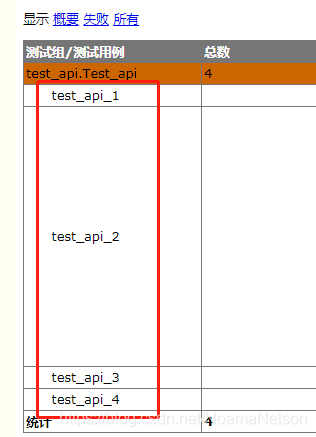
②修改后的报告标题: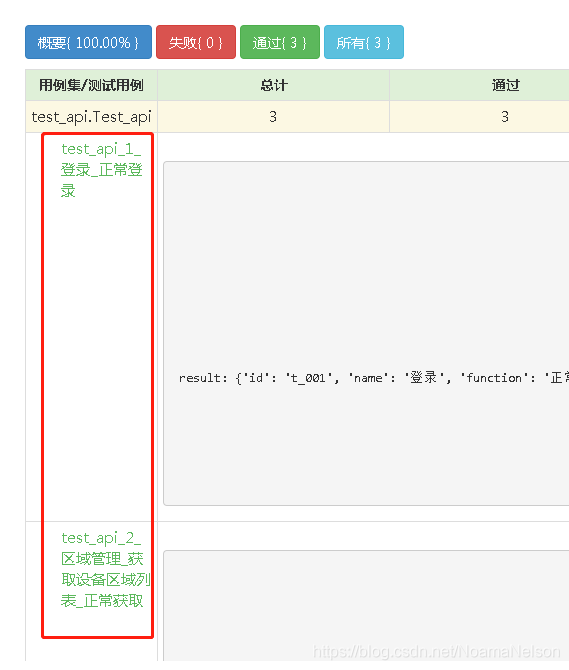
③ 如何修改?
可以参考之前的博文:
unittest中使用ddt后生成的测试报告名称如何修改?(如test_api_0修改成test_api_0_titile)
def mk_test_name(name, value, index=0):
"""
Generate a new name for a test case.
It will take the original test name and append an ordinal index and a
string representation of the value, and convert the result into a valid
python identifier by replacing extraneous characters with ``_``.
We avoid doing str(value) if dealing with non-trivial values.
The problem is possible different names with different runs, e.g.
different order of dictionary keys (see PYTHONHASHSEED) or dealing
with mock objects.
Trivial scalar values are passed as is.
A "trivial" value is a plain scalar, or a tuple or list consisting
only of trivial values.
"""
# Add zeros before index to keep order
index = "{0:0{1}}".format(index + 1, index_len, )
if not is_trivial(value) and type(value) is not dict: # 增加的地方,增加value的字典判断
return "{0}_{1}_{2}".format(name, index, value.name) # 修改的地方,增加返回的值
if type(value) is dict: # 增加的地方
try: # 增加的地方
value = value["name"] + "_" + value["function"] # 增加的地方,name和function必须是execl用例中整正存在的表头,这里我是把两个表头合并了(name是我表格中接口的名称,function是表格中接口的功能描述)
except: # 增加的地方
return "{0}_{1}".format(name.index) # 增加的地方
try:
value = str(value)
except UnicodeEncodeError:
# fallback for python2
value = value.encode('ascii', 'backslashreplace')
test_name = "{0}_{1}_{2}".format(name, index, value) # 修改的地方
return re.sub(r'\W|^(?=\d)', '_', test_name)
4.4.2、增加用例执行人
在HTMLTestRunner.py中加入如下,即获取当前用例执行的负载机的用户名
DEFAULT_TESTER = getpass.getuser()4.5、增加log日志
4.5.1、在框架入口中直接加入run_this.py
# LOG日志记录
logging.basicConfig(level=logging.DEBUG,
format='%(asctime)s %(filename)s[line:%(lineno)d] %(levelname)s %(message)s',
datefmt='%a, %d %b %Y %H:%M:%S',
filename=log_path + '/' + now + r"result.log",
filemode='w')
logger = logging.getLogger()
logger.info(all_case)详细可以参考之前的博文:
Unittest接口测试生成报告和日志方法
4.5.2、在其它模块中直接使用即可
log = logging.getLogger()
log.info("请求头部:", headers)